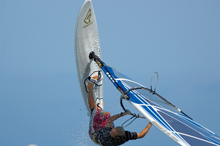This successful range is carried over without change from last year. Although this board was effectively the biggest on test and carries the ‘freestyle-wave’ tag, potential waveboard buyers should not be immediately put off by this as it has loads to offer in the wave environment.
On theWater:
It is the widest board on test with the flattest rocker through the tail so, not surprisingly, it planes very early and feels very stable. Its speed onto the plane is between average waveboard and fast-tail all-rounder, and this allows it to benefit from sails even up to 5.7 at a pinch, certainly comfortably up to 5.5m. The beauty of the board is that while it enjoys a lot of the speed and blasting benefits of a fast-tail all-rounder (freestyle-wave) it still has that comfortable, easy, manoeuvrable and controllable feel of a waveboard. It tracks easily, allowing fast, easy progress upwind and easy jumping and it’s very versatile in the gybe, allowing either snappy or faster drawn-out turns. On small to medium waves it feels very balanced and is fun and easy to turn. It may not offer all the performance, snap or flow of the best onshore riders but it is still basically a very good riding board in moderate conditions. In bigger waves its width and size started to become a problem with the higher boardspeed. Although the board has good width of range, average weight sailors will find it starts to become a bit bouncy and cumbersome when very well powered with sails below 4.7m.
Fittings:
It features a Powerbox fin fitting – great for those who like to remove their fin after a day’s sailing.The fin itself is G10 and seems to suit the board very well. See comments in the Goya CustomWave Series 75 for straps.
Popularity:
Ironically it was more popular with the testers than guesters, largely because of the stronger conditions itwas used in by the guesters (though the one guester who already owned one, not surprisingly, loved it!) Itwas verymuch liked by all the testers who loved the performance it delivered in medium to moderate waveboard winds.
Overall:
Despite the 77L tag, this board should not be thought of as a conventional mid-sized waveboard. It is clearly bigger than that, but it has the faster rocker and performance to match its size and thus occupies a slightly unusual but extremely useful niche. It is above all really easy to sail and extremely versatile and can potentially fill a gap in just about anybody’s quiver. For average to heavier-weight competent sailors (70-90kg) it’s an excellent wave all-rounder for 5.5-5.0m conditions, particularly where waves are likely to be medium to small and predominantly onshore. For lightweights (60-70kg) it’s a perfect, slightly wave-biassed, moderate wind freestyle-wave in the same windstrength. However, it will perhaps be most sought after by medium to slightly heavier sailors (70-85kg) looking either for a very accessible first waveboard or a high wind board to use predominantly in sheltered waters, with much of the feel and control of a waveboard but without many of the attendant difficulties.





